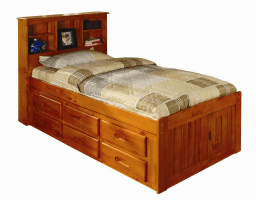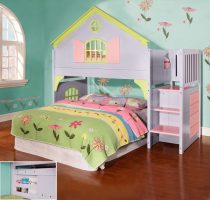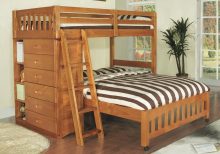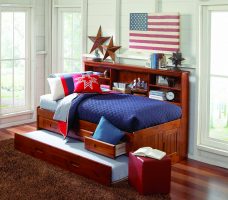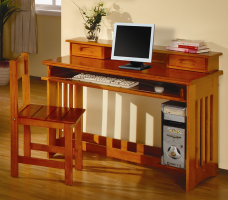4 Furniture Safety Tips Every Parent Should Know
By Andrew Lalia, Founder & CEO of Kids Furniture Solutions LLC
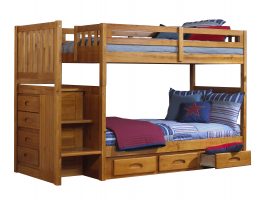 Safety is the first thing in every parent’s mind, but all too often questions about safe practices and other precautions are overlooked when buying furniture for kids. Sometimes, parents are simply asking the wrong questions and may unknowingly put their children at risk. From my experience in the furniture industry as the CEO of a small business, I would like to share my knowledge with you about how to make your child’s room safer.
Safety is the first thing in every parent’s mind, but all too often questions about safe practices and other precautions are overlooked when buying furniture for kids. Sometimes, parents are simply asking the wrong questions and may unknowingly put their children at risk. From my experience in the furniture industry as the CEO of a small business, I would like to share my knowledge with you about how to make your child’s room safer.
In the U.S., household products are manufactured and sold under strict guidelines outlined by the Consumer Product Safety Commission (CPSC). You can read more about the specific guidelines and laws here if you are interested.
Although there is no question that the standards and practices in the U.S. are second to none, accidents do happen. According to the CPSC, every year in the U.S. approximately 22,000 children aged 8 years-old or younger visit emergency rooms for furniture-related accidents. Sadly, these accidents often cause serious injury and can even be fatal.
The good news, however, is that there are simple and inexpensive steps that every parent can take right now to avoid a tragedy from happening in their homes.
In my many years of experience in the furniture industry I have seen it all, and I want to share my experience with you to help make your children’s lives safer. Here are the four most common furniture problems parents should look for and how to fix them.
Drawer Security Should Be Concern #1
Most accidents occur when furniture falls on a child, because it was unstable and likely to tip over. The biggest culprits for this instability are the drawers. Although they are designed to slide open with ease, if multiple drawers are open at once, they can easily shift a unit’s weight and cause it to fall forward.
Many office filing cabinets are built with this danger in mind, since they’re generally made from lighter materials and have the propensity to tip. Normally filing cabinets allow for only one drawer to open at a time, locking the others in place until it closes again.
Unlike office filing cabinets, bedroom furniture is heavier, and thus less likely to tip over, so the first step is to make sure any unit you buy is made of heavier, sturdy wood. However, even this added weight does not make them immune to tipping.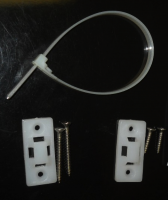
An added precaution for taller furniture such as bookcases, dressers and chests is to anchor the back of the unit to the wall. Normally, these units will come with an anti-tip kit, which allows you to secure it to the wall with screws or zip ties. If you don’t have an anti-tip kit, they are readily available at online retailers like Amazon.com or most furniture merchants.
All drawers in your home should also include an automatic drawer stop, which is standard on models sold today, be specially in older furniture. If your model lacks this feature, it’s a major red flag. ut it is important to check,A drawer stop will prevent a child from unintentionally pulling a draw out of the unit, which could end up coming loose and falling on him. The design is actually quite simple – a drawer will use a wheel and track system to slide in and out of place. At the outer end of the metal track, a small lip in the track will catch the wheel before the drawer can come loose from the unit.

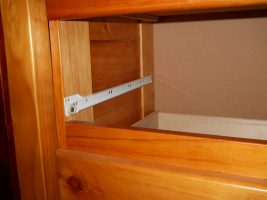
It’s a quick thing to check, since you can easily remove a drawer from an example unit by lifting it while empty, or you can simply check whether the feature is there when you’re assembling your furniture.
Safety on the Top Bunk # 2
Bunk beds are a fun, space saving option for any kid’s bedroom but just like any other household product, if installed or used improperly, they can have some serious hidden dangers.
According to the federal mandated guidelines of the CPSC and the manufacturing standards laid out by ASTM International, no child under the age of six should be on a top bunk. The top bed is simply not designed for very young children. This CPSC mandate is required for all bunk beds sold within the United States and warning labels can be found on both the furniture itself and its packaging. Be sure to thoroughly read these warnings and contact the manufacturer or retail store if you have any concerns.
If your child is old enough to sleep on the top bunk, there are still some basic guidelines to follow. First, the bed should have guardrails installed with at least 5 inches of space between the top of the mattress and the top of the guardrail. Most manufacturers include a maximum mattress thickness and it is important to keep this in mind when buying a custom mattress. Be careful with add-ons like “Bunkie Boards” and mattress supports, as they can also add to the height of the mattress and put you in the danger zone.
Second, check that the guardrails are fastened securely and can’t be removed with a switch or lever. This will lessen the chance that the guardrail can be accidentally removed. If the guardrails do have a switch like this, some simple supplies like wooden pegs or plastic screws – found at any hardware store – can be installed to block the movement of the switch. However, if you have any concerns that your modifications weaken the integrity of the bed, consult a local professional.
The guardrails should also always be able to support the weight of your child, so it is also important to test them with a few gentle pushes and pulls after assembly and check the manufacturer’s weight specifications. Be sure not to cause any unintentional damage and weaken the bed. Remember, a gentle push and pull is all you need. If you feel the rails moving at all, it is cause for concern and you should contact the manufacturer.
Lastly the CPSC mandates that any gaps in the guardrails, headboard, footboard, or slat kit (the foundation below the mattress) does not contain any gap greater than 3.5 inches or less than 9 inches. This standard is designed to prevent a child from slipping through any gaps and getting stuck. For an older or defective bunk bed with openings that are too large, replacing the bed is likely your best option. One often-overlooked gap is the one between the bed and the wall, so it is good to check this every few months to make sure there is no possible threat of entrapment.
Not All Ladders Are Created Equal # 3
Every step should be taken to ensure that a child will not climb on furniture that is not designed for climbing. This helps prevent both falls and tipped units that could cause serious injury. But what should you do about the furniture meant to be scaled?
The item that most commonly fits this description: bunk bed ladders.
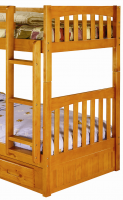
One major thing to realize is that some ladders are far safer than others. The “classic” ladders come in two forms, straight and angled. Straight ladders are placed vertically, perpendicular to the floor as shown in the image to the left. These ladders are more difficult to climb because the climber’s center of gravity lies outside the plane of the ladder. For younger children who are still developing strength or those just waking up from sleep, this type of ladder is certainly not the best option.
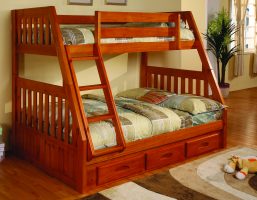 Angled ladders (which are sometimes referred to as tilted ladders) are designed at an angle to the top bunk. This angle helps climbers maintain their center of gravity above the steps, helping to maintain balance. Angled ladders are considerably safer than straight ladders and help reduce the chance of falling. However, if the ladder becomes loosened from use, isn’t fastened properly, or is played on, it still poses risks.
Angled ladders (which are sometimes referred to as tilted ladders) are designed at an angle to the top bunk. This angle helps climbers maintain their center of gravity above the steps, helping to maintain balance. Angled ladders are considerably safer than straight ladders and help reduce the chance of falling. However, if the ladder becomes loosened from use, isn’t fastened properly, or is played on, it still poses risks.
The safest option for a bunk bed is to avoid the ladder altogether. “Stair Stepper” beds are a great 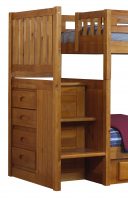 alternative featuring a built-in staircase instead of aladder. This eliminates climbing angles and provides wider, sturdier footing for children. It is also easier for parents to climb up to the top bunk when needed. Some models even offer extra storage space under the stairs. However, for models with extra storage under the stairs, pay attention to the placement of the drawers. Some drawers open directly on to the stairs and if left open, pose a tripping risk. Look for beds that have drawers on the side of the unit instead, which will not be in a position to obstruct children walking up them.
alternative featuring a built-in staircase instead of aladder. This eliminates climbing angles and provides wider, sturdier footing for children. It is also easier for parents to climb up to the top bunk when needed. Some models even offer extra storage space under the stairs. However, for models with extra storage under the stairs, pay attention to the placement of the drawers. Some drawers open directly on to the stairs and if left open, pose a tripping risk. Look for beds that have drawers on the side of the unit instead, which will not be in a position to obstruct children walking up them.
Safety in Construction # 4
No matter the design poor construction can make any furniture unit unsafe, but there are a few key things to look out for.
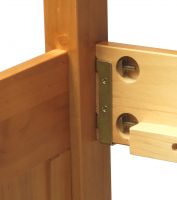
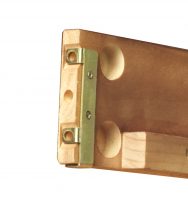 Metal-on-metal connections: instead of wood-on-wood or metal-on-wood connections, metal-on-metal connections are the gold standard for construction when it comes to safety, providing the strongest possible joints for wood furniture. These connections (pictured right) are usually metal bolts, wing nuts, and metal brackets located on individual components of the furniture and are hidden in the final assembly to preserve an all-wood look. These connections help to prevent the weakening and widening of drill holes that can occur as the wood ages and wears from use.
Metal-on-metal connections: instead of wood-on-wood or metal-on-wood connections, metal-on-metal connections are the gold standard for construction when it comes to safety, providing the strongest possible joints for wood furniture. These connections (pictured right) are usually metal bolts, wing nuts, and metal brackets located on individual components of the furniture and are hidden in the final assembly to preserve an all-wood look. These connections help to prevent the weakening and widening of drill holes that can occur as the wood ages and wears from use.
If you have an older unit that doesn’t utilize metal-on-metal connections, the safest bet is to purchase a new unit, because attempting to upgrade an older unit to metal on metal connections is not recommended in most cases. The drilling and cutting that may be required to complete this upgrade may result in a compromised structural integrity of the wood.
Something else to look out for in construction is how bunk beds are stacked, making sure that the top bunk is properly secured to the bottom bed. One approved connection uses a wooden dowel and simple holes drilled into each support. In order to be within safety compliance with the CPSC, it is mandated that a bunk must be lifted 1 ¾ inches above the dowel in order to disengage the beds. Be sure to keep this minimum height in mind when replacing old or broken dowels to keep this connection safe and check during assembly that your unit meets this standard.
The second type of connection approved for bunk beds is a fastening device, which may be metal or wood. The fastening device spans the seam between the top and bottom bunk, held in place with screws and prevents the top bunk from sliding off the bottom supports.
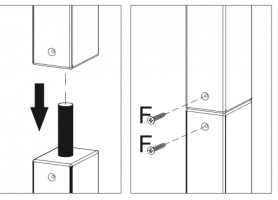 Although only one of these standards is required for any bed, the safest possible connection between
Although only one of these standards is required for any bed, the safest possible connection between
the top and bottom bunk combines both of these methods. An example is a dowel connection that uses screws on both sides of the connection to prevent the bed from ever lifting above the 1 ¾” threshold. (See the illustration to the left)
Lastly, the materials used in the construction of wood furniture are important to understand. The weakest and cheapest materials are also the most likely to break, splinter, or give out and in my opinion they are not durable enough to be used in a child’s bedroom.
If you see that a unit you’re considering has components made from particle board, steer clear. Particle board is an engineered wood product made from wood chips, saw mill shavings and sawdust that are glued together. This type of material has reduced strength compared to other options and is typically used when manufacturer costs are kept low.
A better option – and one that won’t break the bank – is medium-density fiberboard, or MDF. A dense wood product, it is made from hard wood fibers and is structurally stronger than particle board. MDF more closely matches the strength of solid wood with the benefit of being friendly to painted finishes, since the wood doesn’t contain sap and knots from the original tree. As a result, paint is unlikely to discolor the paint or to crack and chip.
Lastly, there is simply no comparison to natural beauty and durability of a unit made from solid wood. Look for a unit with a solid wood frame, especially in the load-bearing areas, which ensure the unit will be durable and solid for years.
Furniture Safety and Additional Resources
Although it may be the single most important thing for parents to consider, furniture safety is all too often overlooked. The tips I’ve given you above are a great starting point and I hope they’ve at least inspired you to think about how you can make your child’s bedroom safer.
For any other issues or concerns with furniture safety, often the best thing to do is call your manufacturer or retailer directly and they can give you individualized attention for the unit you’ve purchased. A quick phone call can go very far in limiting dangers in your child’s bedroom.
I also wanted to include a few more helpful resources if you’re interested in doing a little more research or learning more about furniture safety, which you can find below.
Always remember to stay safe!
– Andrew Lalia is the founder and CEO of Kids Furniture Solutions, a Baltimore-based online furniture company. He is also a school teacher for the Baltimore County Public School District, teaching Science to high school students during the school year. He can be contacted at Andrew@kidsfurnituresolutions.com.
Additional kids furniture safety resources:
Consumer Product Safety Commission (CPSC) Children’s Furniture Safety Guides
Home Safety Checklist (Safe Kids USA)
Child Proofing Your Home (One Step Ahead)
http://www.onestepahead.com/custserv/custserv.jsp?pageName=Childproof_Home

